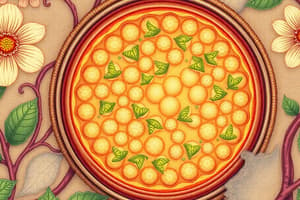Podcast
Questions and Answers
Which of the following characteristics would NOT be observed in mature xylem tissue?
Which of the following characteristics would NOT be observed in mature xylem tissue?
- Dead cells
- Presence of cytoplasm (correct)
- Absence of organelles
- Lignified cell walls
Sieve tube elements contain lignin in their cell walls.
Sieve tube elements contain lignin in their cell walls.
False (B)
Why is it important to lower the coverslip slowly when preparing a wet mount of a stem cross-section?
Why is it important to lower the coverslip slowly when preparing a wet mount of a stem cross-section?
To avoid trapping air bubbles
A stain such as ________ will make xylem and sclerenchyma fibres appear blue-green, while phloem will appear pinkish purple.
A stain such as ________ will make xylem and sclerenchyma fibres appear blue-green, while phloem will appear pinkish purple.
Match the plant tissue type with its corresponding characteristic:
Match the plant tissue type with its corresponding characteristic:
What is the primary reason for the hollow structure of sclerenchyma fibers and xylem vessels?
What is the primary reason for the hollow structure of sclerenchyma fibers and xylem vessels?
Plant fibers' strength is primarily due to the presence of living cell contents within their structure.
Plant fibers' strength is primarily due to the presence of living cell contents within their structure.
Which structure is primarily responsible for maintaining cell turgidity in plant cells, preventing wilting?
Which structure is primarily responsible for maintaining cell turgidity in plant cells, preventing wilting?
Name two specific plant fibers that are commonly used in the production of fabrics.
Name two specific plant fibers that are commonly used in the production of fabrics.
The middle lamella facilitates the transport of substances directly into the cytoplasm of adjacent plant cells.
The middle lamella facilitates the transport of substances directly into the cytoplasm of adjacent plant cells.
In xylem vessels, what structural feature allows for the lateral movement of water and mineral ions between adjacent vessels?
In xylem vessels, what structural feature allows for the lateral movement of water and mineral ions between adjacent vessels?
__________ is a substance that often impregnates the secondary cell wall of plant fibers, contributing to its rigidity and making it difficult for substances to enter or leave.
__________ is a substance that often impregnates the secondary cell wall of plant fibers, contributing to its rigidity and making it difficult for substances to enter or leave.
Match the structural element with its contribution to the strength of plant fibers:
Match the structural element with its contribution to the strength of plant fibers:
The cytoplasmic strands that connect the contents of adjacent plant cells, facilitating cell to cell communication, are known as ______.
The cytoplasmic strands that connect the contents of adjacent plant cells, facilitating cell to cell communication, are known as ______.
Match the following plant cell structures with their primary functions:
Match the following plant cell structures with their primary functions:
Which of the following best describes the primary function of plant stems in relation to leaves?
Which of the following best describes the primary function of plant stems in relation to leaves?
Xylem is located towards the outside of the stem, while phloem is found closer to the middle of the stem.
Xylem is located towards the outside of the stem, while phloem is found closer to the middle of the stem.
Besides transporting water and nutrients, what other crucial function do plant stems perform?
Besides transporting water and nutrients, what other crucial function do plant stems perform?
The two main types of vascular tissue found in plant stems are _ _ _ _ _ and _ _ _ _ _.
The two main types of vascular tissue found in plant stems are _ _ _ _ _ and _ _ _ _ _.
Match each tissue type with its primary function in plant stems:
Match each tissue type with its primary function in plant stems:
Why is the flexibility of plant stems an important adaptation?
Why is the flexibility of plant stems an important adaptation?
Sclerenchyma fibers are associated with the vascular bundles to:
Sclerenchyma fibers are associated with the vascular bundles to:
In what structures are xylem and phloem arranged?
In what structures are xylem and phloem arranged?
Which of the following is the primary function of xylem vessels in plants?
Which of the following is the primary function of xylem vessels in plants?
Phloem tissue primarily transports water and minerals throughout the plant.
Phloem tissue primarily transports water and minerals throughout the plant.
What is the main organic compound transported by phloem, and what is the process of its transport called?
What is the main organic compound transported by phloem, and what is the process of its transport called?
Unlike xylem tissue, mature phloem tissue contains ______ cells.
Unlike xylem tissue, mature phloem tissue contains ______ cells.
Match the cell type found in phloem tissue with its description:
Match the cell type found in phloem tissue with its description:
Which feature is NOT a characteristic of xylem vessel elements?
Which feature is NOT a characteristic of xylem vessel elements?
Phloem tissue provides structural support to the plant.
Phloem tissue provides structural support to the plant.
What is the role of lignin in xylem vessel elements?
What is the role of lignin in xylem vessel elements?
When creating a tissue plan diagram, which guideline is MOST important for accurate representation?
When creating a tissue plan diagram, which guideline is MOST important for accurate representation?
When drawing a tissue plan diagram from a high-power image, it is necessary to draw all the cells visible in the image to ensure accuracy.
When drawing a tissue plan diagram from a high-power image, it is necessary to draw all the cells visible in the image to ensure accuracy.
What is the correct way to draw lines in a plan diagram?
What is the correct way to draw lines in a plan diagram?
When labeling a tissue plan diagram, label lines should stop exactly at the ______ without using arrows.
When labeling a tissue plan diagram, label lines should stop exactly at the ______ without using arrows.
Which of the following should be avoided when creating a tissue plan diagram?
Which of the following should be avoided when creating a tissue plan diagram?
Match the following diagram drawing techniques with their correct description:
Match the following diagram drawing techniques with their correct description:
A student is drawing a tissue plan diagram of a stem. They have identified xylem and phloem. What other tissue type are they likely to find?
A student is drawing a tissue plan diagram of a stem. They have identified xylem and phloem. What other tissue type are they likely to find?
When drawing a tissue plan diagram, shading, including the nucleus, is encouraged to enhance detail and realism.
When drawing a tissue plan diagram, shading, including the nucleus, is encouraged to enhance detail and realism.
Flashcards
Cell wall
Cell wall
The cellulose layer providing structural support and shape to plant cells.
Plasmodesmata
Plasmodesmata
Cytoplasmic connections between plant cells for communication and transport.
Chloroplasts
Chloroplasts
Organelles where photosynthesis occurs, containing chlorophyll and thylakoids.
Amyloplasts
Amyloplasts
Signup and view all the flashcards
Vacuole and tonoplast
Vacuole and tonoplast
Signup and view all the flashcards
Sclerenchyma fibres
Sclerenchyma fibres
Signup and view all the flashcards
Xylem vessels
Xylem vessels
Signup and view all the flashcards
Lignification
Lignification
Signup and view all the flashcards
Cellulose microfibrils
Cellulose microfibrils
Signup and view all the flashcards
Secondary thickening
Secondary thickening
Signup and view all the flashcards
Mature Xylem Tissue
Mature Xylem Tissue
Signup and view all the flashcards
Sieve Tube Elements
Sieve Tube Elements
Signup and view all the flashcards
Toluidine Blue O (TBO)
Toluidine Blue O (TBO)
Signup and view all the flashcards
Tissue Identification Method
Tissue Identification Method
Signup and view all the flashcards
microscope Slide Preparation
microscope Slide Preparation
Signup and view all the flashcards
Xylem Function
Xylem Function
Signup and view all the flashcards
Phloem Function
Phloem Function
Signup and view all the flashcards
Translocation
Translocation
Signup and view all the flashcards
Companion Cells
Companion Cells
Signup and view all the flashcards
Parenchyma Cells
Parenchyma Cells
Signup and view all the flashcards
Xylem Cells
Xylem Cells
Signup and view all the flashcards
Living vs. Dead Cells
Living vs. Dead Cells
Signup and view all the flashcards
Functions of Plant Stems
Functions of Plant Stems
Signup and view all the flashcards
Photosynthesis Support
Photosynthesis Support
Signup and view all the flashcards
Strength and Flexibility
Strength and Flexibility
Signup and view all the flashcards
Transport Requirements for Leaves
Transport Requirements for Leaves
Signup and view all the flashcards
Vascular Tissue
Vascular Tissue
Signup and view all the flashcards
Xylem Location
Xylem Location
Signup and view all the flashcards
Phloem Location
Phloem Location
Signup and view all the flashcards
Light microscope
Light microscope
Signup and view all the flashcards
Phloem sieve tubes
Phloem sieve tubes
Signup and view all the flashcards
Drawing tissue diagrams
Drawing tissue diagrams
Signup and view all the flashcards
Using eyepiece graticule
Using eyepiece graticule
Signup and view all the flashcards
Labeling diagrams
Labeling diagrams
Signup and view all the flashcards
Magnification in drawings
Magnification in drawings
Signup and view all the flashcards
Study Notes
Edexcel International A Level Biology - Plant Structure & Function
-
Plant Cell Structure & Function: Plant cells have a complex system of organelles and structures, including those found in animal cells, plus unique plant-specific organelles
-
Cell Wall: Located outside the cell membrane, providing structural support. Composed of cellulose. Freely permeable to most substances.
-
Middle Lamella: Acts as a glue, composed of pectin, holding adjacent plant cells together.
-
Plasmodesmata: Narrow threads of cytoplasm connecting adjacent plant cells, allowing communication and transport between them.
-
Pits: Thin regions in the cell wall where secondary thickening is absent, facilitating plasmodesmata and transport.
-
Chloroplasts: Larger than mitochondria, double membrane, thylakoids containing chlorophyll, grana, lamellae and DNA. Site of photosynthesis.
-
Amyloplasts: Store starch, commonly found in plant storage organs like potato tubers.
-
Vacuole and Tonoplast: Vacuole is a large, permanent sac in plant cells, surrounded by the tonoplast (selectively permeable membrane). Contains cell sap (water, minerals, waste, enzymes), influencing turgor pressure.
-
Plant Cell Functions: Plant cell organelles and structures have specific functions in maintaining and supporting the plant.
-
4.2 Electron Microscopy of Plant Cells: Electron microscope images show key features of plant organelles like chloroplasts, nucleus, vacuole, cell wall, and mitochondria.
-
4.3 Starch and Cellulose: Structure and Function: Starch is a plant's storage polysaccharide, found in granules in plastids like amyloplasts. Starch is composed of two parts: amylose (unbranched, helical chain) and amylopectin (branched chain). Both use 1,4 glycosidic bonds; amylopectin also has 1,6 glycosidic bonds. Cellulose is a structural polysaccharide made of long chains of β-glucose with 1,4 glycosidic bonds. This inversion in the glucose creates hydrogen bonding between chains, enhancing its strength.
-
4.4 Properties of Cellulose: Cellulose's high tensile strength and properties make it useful for plant fibers in fabrics and other applications like rope.
-
4.5 The Vascular Structure of Plants: Plant stems provide support and transport. Vascular tissue, composed of xylem and phloem, facilitates material movement and plant support.
-
Vascular Tissue: Xylem and phloem collectively form vascular tissue, enabling transport of water, minerals, and organic compounds throughout the plant.
-
Xylem: Transports water and minerals from roots to leaves, providing support from lignified cell walls. Features include lignified cell walls, no end plates, lack of protoplasm.
-
Phloem: Translocates organic compounds (assimilates) from sources to sinks. Consists of sieve tube elements and companion cells.
-
4.6 Core Practical 7: Identifying Tissue Types Within Stems: A practical involving the identification of plant tissues within stem samples using suitable staining techniques, visualization through a microscope and drawing observations.
Studying That Suits You
Use AI to generate personalized quizzes and flashcards to suit your learning preferences.





